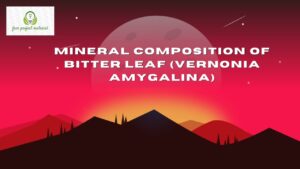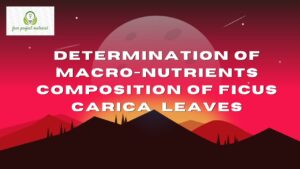ABSTRACT
This study was aim at determining the proximate composition of Tetrapleura tetraptera fruit. The sample was collected from a local market (Urua Ator) in Ikot Ekpene L.G.A., and standard analytical methods were used to analyze the samples. The result of the study revealed the following; Moisture (20.52±0.05%), Ash (15.20±0.07%), crude fibre (20.95±0.15%), crude fat (8.98±0.09%), crude protein (25.10±0.19%), carbohydrate (29.77±0.06%), and caloric value (300.30±0.18%). This indicate that the fruit contains some rich nutritional components as such, it is recommended that the fruit be used as additives in food to enrich the nutritional composition of the foods and also, further studies should be carried out on the antinutritional composition of the fruit in order to ascertain its suitability and safety.
TABLE OF CONTENTS
Title – – – – – – – – – – i
Certification- – – – – – – – – ii
Dedication- – – – – – – – – – iii
Acknowledgements- – – – – – – – iv
Abstract – – – – – – – – – – v
Table of Contents- – – – – – – – – vi-viii
CHAPTER ONE
1.0 Introduction – – – – – – – – 1
- Background of the Study- – – – – – 2
- Aim and objective of the study- – – – – – 3
- Scope and Limitation of Study- – – – – – 4
- Definition of Terms- – – – – – – 5
CHAPTER TWO
2.0 Literature Review – – – – – – – 6
2.1 Botanical Description of Tetrapleura tetraptera– – – 6
2.2 Ethnopharmacology of Tetrapleura tetraptera– – – 7-8
2.3 Photochemistry of Tetrapleura tetraptera– – – – 8-10
2.4 Nutritional value of Tetrapleura tetraptera– – – – 10-11
2.5 Pharmacological Activities of Tetrapleura tetraptera– – 11
2.5.1 Anticonvulsant Activity- – – – – – – 11-13
2.5.2 CNS-Depressant Properties- – – – – – 13-14
2.5.3 Analgesic Activity- – – – – – – 14-15
2.5.4 Anti-Inflammatory Activity – – – – – – 15-16
2.5.5 Antimalarial Activity- – – – – – – 16-17
2.6 Proximate Composition- – – – – – – 17
2.6.1 Moisture- – – – – – – – – 17-20
2.6.2 Protein – – – – – – – – – 20-23
2.6.3 Fat- – – – – – – – – – 23-26
2.6.4 Carbohydrate- – – – – – – – 26-28
2.6.5 Fibre- – – – – – – – – – 28-30
2.6.6 Ash- – – – – – – – – – 30-32
2.6 .7 Energy- – – – – – – – – 32-33
CHAPTER THREE
3.0 Materials and Method – – – – – – 34
3.1 Material and Reagent- – – – – – – 34
3.2 Sample Collection and Preparation- – – – – 34
3.3 Determination of Proximate Composition- – – – 35-43
CHAPTER FOUR
4.0 Results and Discussion – – – – – – 44
4.1 Results- – – – – – – – – 44
4.2 Discussion- – – – – – – – – 45-48
CHAPTER FIVE
5.0 Conclusion and Recommendation- – – – – 49
5.1 Conclusion- – – – – – – – – 49
5.2 Recommendation – – – – – – – 49
References
CHAPTER ONE
1.0 INTRODUCTION
Tetrapleura tetraptera is a medicinal food plants and have a folkloric and ethnomedical uses in Western Africa. The use of wild fruit trees as food and medicine is a popular practice in developing economies like rural Africa (Abdou et al., 2012). Indeed, the tree known as Aridan in western Nigeria or prekesse for the people of Akan from Ghana, has molluscicidal, antimicrobial, antiseptic, neuromuscular, anticonvulsant, anti-inflammatory, cardiovascular, hypoglycaemic, hypotensive, antiuclerative, trypanocidal, hinidicidal properties (Kuate et al., 2015). Arthritis, diabetes, pains, rheumatic, leprosy convulsions, hypertension, is treated through the leaves, bark, roots, kernels of the plants in ethnomedicine. In Nigeria, Tetrapleura tetraptera fruits are commonly used in local cooking as popular seasoning spice (Kuate et al., 2015). The fleshy pulps have a characteristically pungent aromatic odour, which contributes to its insect-repellent and flavoring property (Ogbunugafor et al., 2017).
1.1 BACKGROUND OF THE STUDY
Tetrapleura tetraptera (family fabaceae) is a deciduous tree native to tropical Africa; the tree grows up to 25m high, with a diameter at breast height (DBH) of 1.5-3.0m. Although its preferred habitats are savannah, woodland, dry forest and riverine forest, it is most common in dense rainforests and preserved forest patches around villages. The stem bark is fairly smooth, greyish-brown and then, leaves are attached directly by the base having an intervening stalk, some 15-30cm long and slightly channeled on the upperhase.
Fruit has been described as being persistent hanging at the ends of branches on stout stalk 25cm long. The fruit appears green when still tender but on maturity and ripening, it is shiny, smooth, dark-purple-brown (Burkill, 2000).
Tetrapleura tetrapetra growing in most parts of West Africa begins to flower by the middle and end of February till the early or mid-April when young tender green fruits begin to appear. The mature fruits are ripe from September to December and may be collected from the trees when they drop. The fruits contain oily, aromatic and sugary substances. Their smells attract insects, termites, animals and even humans who need them for food and other uses.
1.2 AIM AND OBJECTIVE OF THE STUDY
The aim of the study is to analyze the proximate composition of Tetrapleura tetraptera fruit.
THE OBJECTIVES OF THIS STUDY ARE:-
- To determine the moisture content in Tetrapleura tetraptera
- To determine the Ash content in Tetrapleura tetraptera
- To determine the fiber content in Tetrapleura tetrapetera
- To determine the fat content in Tetrapleura tetraptera
- To determine the crude protein content in Tetrapleura tetraptera
1.3 SCOPE AND LIMITATION OF THE STUDY
The study covers the determination of the proximate composition of Tetrapleura tetraptera due to financial and time constraint.
1.4 DEFINITION OF TERMS
PROXIMATE COMPOSITION: Proximate composition is the term used in the field of feed and food and means the composition of moisture, protein, crude fiber, crude ash, fat and carbohydrates which are exposed as the content (%) on the sample respectively.
Tetrapleura tetraptera: Tetrapleura tetraptera is a species of flowering plant in the pea family native to Western Africa. It is mostly used to prepared palm nut soup and other types of soups called light soup because of its aroma.
Ethnopharmacology: Ethnopharmacology studies natural medicines derived from plants and other substances that have been traditionally used by group of people to treat various human disease. The scientific study of traditional medicines is named “Ethnopharmacology”.
PHYTOCHEMISTRY: Phytochemistry is the study of phytochemicals, which are chemicals derived from plants. It is the branch of chemistry concerned with plants, their chemical composition and processes.
ANTICONVULSANT: Anticonvulsant is a diverse group of pharmacological agent used in the treatment of epileptic seizures. It is medicines that prevent or treat convulsions (Seizures).



